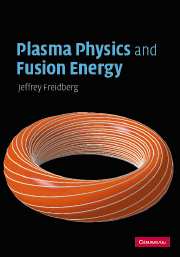Book contents
- Frontmatter
- Contents
- Preface
- Acknowledgements
- Units
- Part I Fusion power
- 1 Fusion and world energy
- 2 The fusion reaction
- 3 Fusion power generation
- 4 Power balance in a fusion reactor
- 5 Design of a simple magnetic fusion reactor
- Part II The plasma physics of fusion energy
- Appendix A Analytical derivation of 〈ς v〉
- Appendix B Radiation from an accelerating charge
- Appendix C Derivation of Boozer coordinates
- Appendix D Poynting's theorem
- Index
- References
5 - Design of a simple magnetic fusion reactor
Published online by Cambridge University Press: 14 May 2010
- Frontmatter
- Contents
- Preface
- Acknowledgements
- Units
- Part I Fusion power
- 1 Fusion and world energy
- 2 The fusion reaction
- 3 Fusion power generation
- 4 Power balance in a fusion reactor
- 5 Design of a simple magnetic fusion reactor
- Part II The plasma physics of fusion energy
- Appendix A Analytical derivation of 〈ς v〉
- Appendix B Radiation from an accelerating charge
- Appendix C Derivation of Boozer coordinates
- Appendix D Poynting's theorem
- Index
- References
Summary
Introduction
Power balance considerations have shown that a magnetic fusion reactor should operate at a temperature of about 15 keV and be designed to achieve a value of pτE > 8.3 atm s. Even so, these considerations do not shed any light on the optimum tradeoff between p and τE. Nor do they provide any insight into the geometric scale and magnetic field of a fusion reactor. This is the goal of Chapter 5, which presents the design of a simple magnetic fusion reactor. All geometric and magnetic quantities are calculated as well as the critical plasma physics parameters.
Remarkably, the design requires virtually no knowledge of plasma physics even though for nearly half a century the field has been dominated by the study of this new branch of science. The design is actually driven largely by basic engineering and nuclear physics constraints. These constraints determine the geometric scale of the reactor as well as the size of the magnetic field. Equally important, they make “demands” on the plasma parameters. Plasma physicists must learn how to create plasmas that satisfy these demands (e.g. pressure and confinement time) in order for fusion to become a commercially viable source of energy. Knowledge of the desired plasma parameters is crucial as it defines the end goals of fusion-related plasma physics research, and serves as the guiding motivation for essentially all of the discussion of plasma physics in the remainder of the book.
- Type
- Chapter
- Information
- Plasma Physics and Fusion Energy , pp. 85 - 108Publisher: Cambridge University PressPrint publication year: 2007



